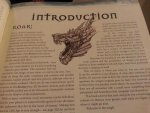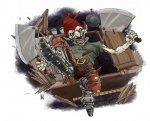Dungeoneer
First Post

I’ve just finished reading the 13th Age Bestiary and it completely blew me away. Seriously, expectations exceeded at every level. I admit, I am a sucker for a good monster book, but this is a great one. Let me say up front that any GM looking for inspiring monsters should find something to love in the Bestiary, regardless of what system they are running. Don’t think that just because it says 13th Age on the cover that it can’t be useful for your 5e or Pathfinder game.
The meat of this book is fifty-two monsters, or categories of monsters, really. Most monsters have at least a one or two variants and often there are three or even more. For example, the entry for Red Dragon contains write-ups for 7th level Volcano Dragon, a 9th level Hoardsong Dragon, a 9th level Hoard Spirit, an 11th level Greathoard Elder, a 12th level Flamewreathed Dragon and 12th level smoke minions (note that when there are minor monsters like Hoard Spirits that are part of another monster’s ecology, they are included in its section). This works out to a total of 202 monster variants.
A great many of the monsters are classic D&D baddies, brilliantly reimagined. For example, there’s the chimera whose abilities shift at the beginning of each battle. Cambions are now demonic assassins for hire who grow their lethal weapons out of their own flesh and bone. And if you like Gelatinous Cubes, you’re going to love Gelatinous Dodecahedrons!
My personal favorite classic monster getting the 13th Age treatment is the Redcap. 13th Age redcaps get their red caps by dipping them in their victims’ blood, so the redness of a redcap’s headgear tells you how tough it is. Before combat with redcaps, the GM picks a ‘bad word’ and when someone at the table says it the redcaps can instantly teleport to get the jump on the players. As a GM, just imagining the look on my players’ faces when that happens gives me a smile.
There are numerous more obscure monsters brought vividly to life, like the Couatl, the Jorogumo, the Wendigo and the Shadow Dragon. All are given vivid new life. And some monsters are entirely new to this kind of game (as far as I’m aware), like the Whispering Prophet (spooky aberrant infiltrators), the Wibble (magical mistakes) and the Zorigami (mysterious clockwork constructs with time shifting capabilities). There are also new monsters specifically for the Dragon Empire setting, including Blue Sorcerers, Warbanners and The Saved.
If the Core Book had a weakness, it was the monster section. Due to space constraints, some of the monsters seemed a little bit vanilla and played as under-powered. This book seeks to address that in several instances, where core book monsters have been given a more stylish and lethal makeover. "Oh those core book black dragons? They were the crappy black dragons. These are the real deal!"
The Bestiary even includes stats for two monsters it recommends that GMs think twice about using - rust monsters and the Terrasque. Yes, these are real rust monsters that will dissolve your players equipment and make them hate you forever. No fooling around here. They come with a big fat warning, but they are available for GMs that want them. The Terrasque, meanwhile, has been given stats that start at virtually unbeatable and can be tweaked upwards to flat out impossible.
A good monster is more than just its stats. For those grognards who want a full ecology write-up next to their monster’s stat block, a great many of these monsters have one. Where might you find said monster? What does this monster eat? What does it do in its spare time? What sort of allies might this monster have? Does it pair well with kobolds (answer: yes)? Each monster also includes advice on building battles and some suggested plot hooks.
Some monsters get a complete lifecycle. The best example of this is the remorhaz. The remorhaz has a full five different stages written up as separate monsters, and the first couple won’t necessarily clue in players about what these critters will grow up to be. Letting one of your players adopt a mewling 'snow kitten' and watching as it gets bigger, uglier and meaner could be a lot of fun!
This being 13th Age, very little is set in stone. Origin stories, in particular, are often left to the player, albeit with several hints for GMs who want them. And sometimes, as the book says, “a purple worm is just a purple worm.” The purple worm in this book, by the way, is a serious engine of destruction fully capable of swallowing some or all of your players whole and digesting them in its highly acidic stomach. The designers really haven’t pulled any punches.
If this book was just a collection of flavorful, well-executed monsters it would be great but there’s more here. The designers love lists and start out with several, including “Monsters that might negotiate a treaty with you” and “Monsters that lay fearsome eggs.” The monsters themselves often come with entertaining lists: “Things found in a black dragon’s hoard” or “Things Blue Sorcerers carry” or “Things found in the stomach of a Bulette.”
But wait, there’s still more! There are tables of attributes to roll on to make monsters more fun/interesting/terrifying. If a monster can be found in a particularly perilous environment there are tables of environmental effects. The Shadow Dragon entry includes some lovely cursed items. The entry on Kobolds has tables of random traps (one table per environment!) that they can drag players into during battle!
And, for those pesky players, there is even a playable monster race. And it’s where you’d least expect it… under the Fungaloid entry. Yes, Mycotic Twygzogs are now a playable race in 13th Age. This might be the first official support for sexy mushroom princes in a d20 game.
Yes that’s kind of random, but it gives you an idea of how fun this book is. It’s not just a book of monsters. It’s a book of unique backstories, world-building details and bits of lore. And lots of surprises. For both the GM and his or her unfortunate players!
As with both the Core book and 13 True Ways, the Bestiary is written in an informal style with the authors occasionally breaking in to address the reader directly and explain why they’ve done what they did. To me this is just about empowering the GM and players as much as possible to make the game their own, and it is one of the things I love most about 13th Age.
The final section of the book, aside from some charts and the necessary monsters-by-level list, walks the reader through monster creation, from re-skinning a monster to building one from scratch. This may seem redundant to experienced GMs but I think it’s great that the designers realized this is something not everyone is confident about doing on their own. And in fact even self-styled designers can learn a thing or two here, as the book breaks down the ‘technology’ used to build 13th Age monsters, how to apply it and when.
If you have never looked at a 13th Age monster, the two things that will stand out to you are special abilities that trigger based on the natural roll of the d20, and the escalation die. Monsters are basically constructed around these two concepts and they can get complicated.
In fact my one complaint about this book is that occasionally some monster entries seemed over fiddly, with multiple riders tacked on for natural even misses, natural odd misses, natural 16+ and natural 18+. Still, I suppose that at the end of the day you roll the d20, look at the list of riders, and do what it says. So I won’t complain too much.

So here’s the tldr version: lots of cool monsters that seem like they would be fun to run at the table. Rich seams of lore and backstory to steal from. Copious adventure hooks. Clever new mechanics. Tables of stuff to roll on. And a playable race.
Kids, this book is value for money. I’m serious.
The designers were lead by Rob Heinsoo, who helped create 13th Age. This is the first time a 13th Age book has not been mostly the product of Rob, Jonathan Tweet and illustrator Lee Moyer. Props to Ryven Cedrylle, Kenneth Hite, Kevin Kulp, ASH LAW, Cal Moore, Steve Townshend, Rob Watkins and Rob Wieland who prove that Rob and Jonathan aren’t the only guys who can come up with great stuff in this game.
Oh hey, I should probably mention the art. The stuff within the pages is by Rich Longmoore. Every monster gets at least one full-color piece. There are some fantastically evocative pieces in here. This is way beyond the ‘inscribed gems’ that made up the monster art for the core book. Kudos to everyone involved.
Finally, for your casual perusal, here is the list of the monster categories in the Bestiary. Enjoy.
- Basilisk
- Bat
- Black Dragon
- Blue Sorcerer
- Bugbear
- Bulette
- Cambion Assassin
- Centaur
- Chaos Beast
- Chimera
- Chuul
- Couatl
- Drow
- Dybbuk
- Elder Beast
- Ettercap
- Frost Giant
- Fungaloid
- Gelahedron (Gelatinous Platonic Solids)
- Genie
- Ghoul
- Golem
- Hag
- Haunted Skull
- Hellbug
- Intellect Devourer
- Jorogumo
- Kobold
- Lammasu
- Lich
- Manticore
- Naga
- Ogre
- Ogre Mage
- Orc
- Predatory Plant
- Purple Worm
- Red Dragon
- Redcap
- Remorhaz
- Rust Monster
- Sahuagin
- Shadow Dragon
- Stirge
- Tarrasque
- The Saved
- Warbanner
- Wendigo
- Whispering Prophet
- White Dragon
- Wibble
- Zorigami
Last edited:










